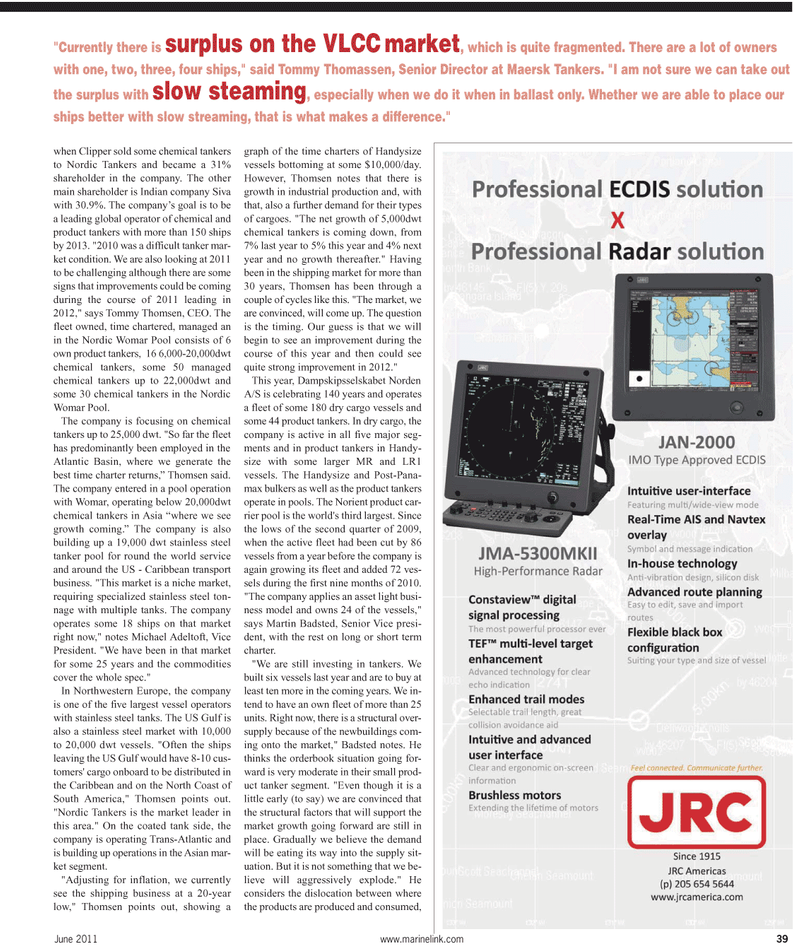
Page 43: of Maritime Reporter Magazine (June 2011)
Feature: Annual World Yearbook
Read this page in Pdf, Flash or Html5 edition of June 2011 Maritime Reporter Magazine
when Clipper sold some chemical tankers to Nordic Tankers and became a 31% shareholder in the company. The other main shareholder is Indian company Siva with 30.9%. The companys goal is to be a leading global operator of chemical andproduct tankers with more than 150 ships by 2013. "2010 was a difficult tanker mar- ket condition. We are also looking at 2011 to be challenging although there are somesigns that improvements could be coming during the course of 2011 leading in2012," says Tommy Thomsen, CEO. The fleet owned, time chartered, managed an in the Nordic Womar Pool consists of 6 own product tankers, 16 6,000-20,000dwt chemical tankers, some 50 managed chemical tankers up to 22,000dwt and some 30 chemical tankers in the Nordic Womar Pool. The company is focusing on chemical tankers up to 25,000 dwt. "So far the fleet has predominantly been employed in the Atlantic Basin, where we generate thebest time charter returns,? Thomsen said. The company entered in a pool operation with Womar, operating below 20,000dwt chemical tankers in Asia where we see growth coming.? The company is also building up a 19,000 dwt stainless steel tanker pool for round the world service and around the US - Caribbean transportbusiness. "This market is a niche market, requiring specialized stainless steel ton-nage with multiple tanks. The company operates some 18 ships on that market right now," notes Michael Adeltoft, Vice President. "We have been in that market for some 25 years and the commoditiescover the whole spec." In Northwestern Europe, the company is one of the five largest vessel operators with stainless steel tanks. The US Gulf is also a stainless steel market with 10,000 to 20,000 dwt vessels. "Often the ships leaving the US Gulf would have 8-10 cus- tomers' cargo onboard to be distributed in the Caribbean and on the North Coast ofSouth America," Thomsen points out. "Nordic Tankers is the market leader in this area." On the coated tank side, thecompany is operating Trans-Atlantic and is building up operations in the Asian mar- ket segment. "Adjusting for inflation, we currentlysee the shipping business at a 20-year low," Thomsen points out, showing a graph of the time charters of Handysizevessels bottoming at some $10,000/day. However, Thomsen notes that there is growth in industrial production and, with that, also a further demand for their typesof cargoes. "The net growth of 5,000dwt chemical tankers is coming down, from 7% last year to 5% this year and 4% next year and no growth thereafter." Having been in the shipping market for more than 30 years, Thomsen has been through a couple of cycles like this. "The market, we are convinced, will come up. The question is the timing. Our guess is that we willbegin to see an improvement during the course of this year and then could seequite strong improvement in 2012." This year, Dampskipsselskabet Norden A/S is celebrating 140 years and operatesa fleet of some 180 dry cargo vessels and some 44 product tankers. In dry cargo, the company is active in all five major seg- ments and in product tankers in Handy- size with some larger MR and LR1 vessels. The Handysize and Post-Pana- max bulkers as well as the product tankers operate in pools. The Norient product car- rier pool is the world's third largest. Since the lows of the second quarter of 2009, when the active fleet had been cut by 86 vessels from a year before the company is again growing its fleet and added 72 ves- sels during the first nine months of 2010. "The company applies an asset light busi- ness model and owns 24 of the vessels," says Martin Badsted, Senior Vice presi- dent, with the rest on long or short termcharter. "We are still investing in tankers. We built six vessels last year and are to buy at least ten more in the coming years. We in- tend to have an own fleet of more than 25 units. Right now, there is a structural over- supply because of the newbuildings com- ing onto the market," Badsted notes. He thinks the orderbook situation going for- ward is very moderate in their small prod- uct tanker segment. "Even though it is a little early (to say) we are convinced that the structural factors that will support the market growth going forward are still in place. Gradually we believe the demand will be eating its way into the supply sit- uation. But it is not something that we be-lieve will aggressively explode." He considers the dislocation between wherethe products are produced and consumed,June 2011www.marinelink.com 39"Currently there is surplus on the VLCCmarket , which is quite fragmented. There are a lot of owners with one, two, three, four ships," said Tommy Thomassen, Senior Director at Maersk Tankers. "I am not sure we can take out the surplus with slow steaming, especially when we do it when in ballast only. Whether we are able to place our ships better with slow streaming, that is what makes a difference."

 42
42

 44
44
